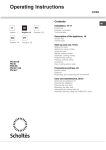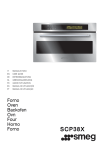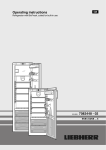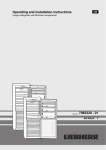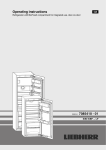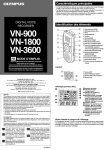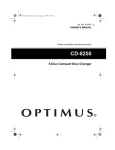Download Smeg SCM38X microwave
Transcript
START STOP 99328004 FR DA DE EN ES IT NL PT GUIDE D'UTILISATION BRUGERVEJLEDNING BETRIEBSANLEITUNG USER GUIDE MANUAL DE UTILIZACIÓN MANUALE D'USO GEBRUIKSAANWIJZING MANUAL DE UTILIZAÇÃO Four Ovn Backofen Oven Horno Forno Oven Forno EN TABLE OF CONTENTS 1 / INFORMATION FOR THE USER • Safety instructions _________________________________________ • Care for the environment ____________________________________ 04 05 2 / INSTALLING YOUR APPLIANCE • Choice of location __________________________________________ • Fitting ____________________________________________________ • Electric connection _________________________________________ 06 06 07 3 / DESCRIPTION OF YOUR APPLIANCE • Introduction to your oven ____________________________________ • Accessories _______________________________________________ • Introduction to the programmer ______________________________ • Introduction to the selecting touch controls ____________________ 09 10 11 11 4 / USING YOUR APPLIANCE • Using the programmer º How to set the time_____________________________________ • Micro-wave cooking ________________________________________ • Automatic micro-wave defrosting _____________________________ • Defrosting guide ___________________________________________ • Combined cooking ________________________________________ • Traditional cooking _________________________________________ • Programmed cooking_______________________________________ • Delayed cooking ___________________________________________ • Customising cooking temperature and power º Traditional cooking _____________________________________ º Micro-wave cooking ____________________________________ º Combined cooking _____________________________________ • Using the timer function_____________________________________ • Locking the controls (child safety) ____________________________ • Display stand-by mode ______________________________________ 20 20 21 22 22 23 5 / OVEN COOKING MODES_______________________________________ 24 6 / CARING FOR AND CLEANING YOUR APPLIANCE • Cleaning the outer surfaces __________________________________ 26 7 / TROUBLESHOOTING __________________________________________ 27 8 / AFTER-SALES SERVICE • Repairs ___________________________________________________ 28 3 12 13 14 15 16 17 18 19 EN 1 / INFORMATION FOR THE USER • For children, always: - heat bottles without the teat, shake the liquid and check its temperature on the back on your hand before feeding the child. - mix and check the temperature of children’s food before eating in order to avoid serious internal burns. • It is recommended to cover food in most cases; it will have more flavour and your appliance will remain cleaner for longer. However, before cooking or reheating liquids in a bottle or sealed container, you must remove the cap or lid to avoid the risk of explosion. • Never heat or cook eggs in the microwave in their shells, on a dish or on a plate. They are liable to explode even after the cooking has finished and risk causing serious burns and/or irreparable damage to your microwave oven. • Heating beverages in the micro-wave oven can cause sudden and/or delayed splattering of boiling liquid, so precautions must be taken when handling their containers. • In the case of small quantities (a sausage, croissant, etc.) place a glass of water next to the food. • Excessive cooking times may dry out foods and burn them. To avoid such incidents, never use the same times recommended for cooking in a traditional oven. • If you notice the appearance of smoke, leave the door of the appliance shut, turn off the power or disconnect the oven from the power supply. • This appliance is not intended for use by persons (including children) with impaired physical, sensory or mental capacities, or by inexperienced or untrained persons, except if they have been instructed in its operation by a person responsible for their safety. Warning Keep this user guide with your appliance. If the appliance is ever sold or transferred to another person, ensure that the new owner receives the user guide. Please become familiar with these recommendations before installing and using your oven. They were written for your safety and the safety of others. • SAFETY INSTRUCTIONS • Your appliance is designed for standard household use for cooking, reheating and defrosting foods. The manufacturer declines any responsibility in the case of inappropriate use. • Before each use, ensure that any receptacles and accessories are suitable for use in your micro-wave oven (for example: pyrex, porcelain, etc.) • To avoid damaging your appliance, never operate it while empty or without the turntable. • Do not interfere with the orifices on the lock on the front of the appliance; this could cause damage to your appliance that would require a service call. • Check the oven regularly when cooking or heating food in disposable containers made from plastic, paper or other flammable materials to avoid the risk of inflammation. • It is not recommended to use metallic cookware, forks, spoons, knives or metal staples or fasteners for defrosting bags. However, occasionally you can defrost food packaged in low-rise aluminium containers (maximum 4cm) without the lid. However, the reheating time will be slightly longer. In this case, make sure that the container is placed in the centre of the base of the oven; it must never be placed less than 1 cm away the metallic walls or the door of the appliance. • When in use, the appliance becomes hot. Be careful not to touch the heating elements located inside the oven. It is advisable to keep small children away from the oven. 4 EN 1 / INFORMATION FOR THE USER • Never use steam or high-pressure devices to clean the oven (requirement imposed by electrical safety concerns). • Do not modify or attempt to modify any of the characteristics of this appliance. This would be dangerous to your safety. • During cooking, ensure that the door of your oven is completely closed so that the seal can do its job properly. • When placing dishes inside or removing them from the oven, do not place your hands close to the upper heating elements, use heat-protective kitchen gloves. • CARE FOR THE ENVIRONMENT — This appliance’s packing materials are recyclable. Recycle them and play a role in protecting the environment by depositing them in municipal containers provided for this purpose. — Your appliance also contains many recyclable materials. It is therefore marked with this logo to indicate that used appliances must not be mixed with other waste. Recycling of the appliances organised by your manufacturer will thus be undertaken in optimum conditions, in accordance with European directive EC/2002/96 relating to electrical and electronic equipment waste. Consult your city hall or your retailer to find the drop-off points for used appliances that is nearest to your home. — We thank you for your help in protecting the environment. Warning Installation should only be performed by installers and qualified technicians. This appliance complies with the following European directives: - Low Voltage Directive EEC/73/23 modified by directive EEC/93/68 for insertion of EC marking. - Electromagnetic Compatibility Directive 89/336/EEC modified by directive 93/68/EEC for insertion of EC marking. - EC regulation no. 1935/2004 concerning materials and objects intended for contact with food substances. 5 50 10 20 50 2 / INSTALLING YOUR APPLIANCE EN 22 548 550 380 378 393 595 560 550 i min 550 mini 400 560 310 • CHOICE OF LOCATION • FITTING To do this: 1) Remove the rubber screw covers to access the mounting holes. 2) Drill a Ø 2 mm hole in the cabinet panel to avoid splitting the wood. 3) Attach the oven with the two screws. 4) Replace the rubber screw covers (they also serve to absorb the shock caused by closing the oven door). (*) if the cabinet is open, its opening must be 70 mm (maximum). The diagrams above determine the dimensions of a cabinet that will be able to hold your oven. The oven can be installed under a work top or in a column of cabinetry (open* or closed) having the appropriate dimensions for built-in installation (see adjacent diagram). Your oven has optimised air circulation that allows it to achieve remarkable cooking and cleaning results if the following guidelines are followed: • Centre the oven in the cabinet so as to guarantee a minimum distance of 5 mm between the appliance and the neighbouring cabinet. • The material or coating of the cabinet must be heat-resistant. • For increased stability, fix the oven in the cabinet by means of 2 screws through the holes designed for this purpose on the lateral mounts (fig.1). Tip To be certain that you have properly installed your appliance, do not hesitate to seek advice from a household appliance specialist. 6 EN 2 / INSTALLING YOUR APPLIANCE Monophase 20A Counter 220-240V~ 50Hz Monophase line 220-240 V ~ 16A fuse or differential circuit breaker Electrical outlet earth 2 prong receptacle +e CEI Standard 60083 Power supply cable length 1.50 m approx. • ELECTRIC CONNECTION Electrical safety must be provided by a correct build-in. During fitting and maintenance operations, the appliance must be unplugged from the electrical grid; fuses must be switched off or removed. 220-240V~ single-phase grid via the intermediary of a 1 live + 1 neutral + earth CEI 60083 standardised power socket or via an all-pole cut-off device or in compliance with the installation rules. Warning The electrical connection should be performed before the appliance is installed in the cabinet. The safety wire (green-yellow) is connected to the appliance’s terminal and must be connected to the ground lead of the electrical set-up. In the case of connection to an electric wall socket, it must remain accessible after installation. Ensure that: - the electrical installation has sufficient voltage, - the electrical wires are in good condition - the diameter of the wires complies with the installation requirements. The fuse in your set-up must be 10 amperes. If the power cable is damaged, it must be replaced by the manufacturer, its AfterSales Service Department or a similarly qualified person to avoid danger. Your oven must be connected with a (standardised) power cable with 3 conductors of 1.5mm2 (1 live + 1 neutral + earth) which must be connected to a 7 EN 2 / INSTALLING YOUR APPLIANCE Warning We cannot be held responsible for any accident or incident resulting from non-existent, defective or incorrect earthing. If the electrical installation in your residence requires any changes in order to hook up your appliance, call upon a professional electrician. If the oven malfunctions in any way, unplug the appliance or remove the fuse corresponding to the sector where the oven is hooked up. 8 3 / DESCRIPTION OF YOUR APPLIANCE EN • INTRODUCTION TO YOUR OVEN A START STOP B C D A Controls C Lamp B Programmer D Wire shelf supports •Accessories Your appliance is equipped with a flat grid and a glass dish. 9 EN 3 / DESCRIPTION OF YOUR APPLIANCE • ACCESSORIES •Grid (fig.1): Allows you to toast, brown or grill. The grid should not under any circumstances be used with other metal cookware on the micro-wave, grill + micro-wave or circulating heat + microwave settings. However, you can reheat food in an aluminium tray if you insulate it from the grid using a plate. fig.1 •Glass drip tray (fig.2): It can also be used half-full of water for double-boiler cooking methods using the circulating heat function. It can be used as a cooking dish. Please note: fig.2 Take care to place the drip tray in the centre of the side grills to avoid modifying the circulation of air. •Grid + glass drip tray (fig.3): To roast and retain the cooking juices, place the grill on the drip tray. Please note: fig.3 In order to keep your oven clean for all cooking functions, you can place the dish on the base of the oven. Please note: At the end of cooking, do not touch the dishes with bare hands. 10 EN 3 / DESCRIPTION OF YOUR APPLIANCE • INTRODUCTION TO THE PROGRAMMER B A K J C I H G D E F A Cooking modes display G Cooking end time display B Oven temperature display. H Cooking end time indicator C Cooking time indicator I Cooking time indicator D Temperature rise indicator J Control panel lock indicator (child safety device) E Clock or timer display K Cooking time display F Timer indicator • INTRODUCTION TO THE SELECTING TOUCH CONTROLS B A C START STOP D E F G H 11 A Start/Stop B Cooking mode selection C Cooking temperature and micro-wave power D Touch controls E Cooking time F End of cooking G Timer H Locking EN 4 / USING YOUR APPLIANCE •How to set the time START STOP - When supplied with electricity The display flashes at 12:00 (fig.1) fig.1 Set the time by pressing the + or - touch controls (holding your finger on the touch control allows you to scroll through the numbers rapidly). START STOP Example: 12:30 fig.2 Press the START touch control to validate. The time display no longer flashes (fig.2). - To reset the time on the clock START STOP Press and hold the touch control for a few seconds until the display is flashing (fig.1), then release. Audible beeps indicate that it is now possible to set the time. fig.1 Adjust the clock setting with the + and touch controls (fig.2). START STOP Press the START touch control to validate. fig.2 12 EN 4 / USING YOUR APPLIANCE • Micro-wave cooking YOUR OVEN HAS 6 MICRO-WAVE COOKING FUNCTIONS Warning Never turn on the oven in any mode when empty. Press once on the START touch control to START STOP select the function (fig.1). Press the START button a second time to access the cooking time settings (fig.2): - 0.00 flashes - Adjust by pressing the + or – buttons. Example: 30 seconds fig.1 START STOP Adjusting the power level: - Press the button, “1000 w” begins flashing (fig.3). - Adjust by pressing the + or - buttons. Example: 800W - Make sure that the door is firmly closed. fig.2 START STOP Confirm your selection by pressing START. Your oven starts by counting down second by second. fig.3 If necessary, cooking can be stopped by pressing on START/STOP for 1 second. OPENING THE DOOR DURING COOKING When the door is opened during cooking, the oven stops operating. When the door is closed again, cooking can be recommenced by pressing START/STOP. Please note: The function does not need power adjustment. 13 EN 4 / USING YOUR APPLIANCE • AUTOMATIC MICRO-WAVE DEFROSTING With your new micro-wave, say goodbye to hours of waiting for your food to defrost! The microwave is the freezer’s best ally, making it possible to defrost food up to 10 times quicker than at room temperature. Tip: Defrosting time depends on the type of appliance. It also depends on the shape, size, initial temperature and quality of the food. Be sure to remove the metallic tie from the defrosting bag when defrosting food directly in the bag. If there are any ice crystals on the food, remove them with a knife, otherwise the ice will act as a screen and the food will take longer to defrost. Defrost meat and fish by placing it on an upside-down saucer on a plate; this will allow any juices to drain away which otherwise would cause the food to begin to cook if left in contact with it. In order to obtain even defrosting, as soon as possible separate poultry breasts or fish fillets and break apart cubes of meat. Turn over or stir food half-way through defrosting. Leave the food to stand after defrosting. General guidelines: resting time = defrosting time. Never refreeze food unless it has been cooked. 14 EN 4 / USING YOUR APPLIANCE • DEFROSTING GUIDE Food Defrosting bread and pastry French bread Loaf of bread Flaky or short crust Food Defrosting crustaceans Scallops Shelled prawns Whole pink shrimp Prawns (10) Langoustines Food Defrosting Fish Cod or haddock fillets Atlantic cod, hake Sole, plaice (2) Slices of hake Pollock, salmon Trout (3) Food Defrosting Meat Cockerel, pigeon Chicken breast (2) Chicken legs (4) Whole chicken Veal ribs Roast beef Beefburgers (4) Cubes of meat Food Defrosting Fruits Strawberries Raspberries/cherries Gooseberries, blueberries, black currants Quantity 100g 200g 400g 300g Time 45 to 55 sec. 1 to 1 min. 30 secs 2 to 2 min. 30 secs 1 minutes Quantity Time 500g 100g 200g 500g 1,000g 5 minutes 1 min 30 secs to 2 min 5 to 7 min. 11 to 13 min. 10 to 11 min. Quantity Time 400g 500g 300g 1 piece 4 pieces 540g 3 to 4 min. 3 to 4 min. 2 to 2 min. 30 secs 1 min 30 secs to 2 min 4 to 5 min. 4 to 5 min. Quantity 500g to 600g 200g 1,000g 1,000g 600g 1,000g 360g 600g place the glass dish on the base place the glass dish on the base Time 5 to 7 min. Turn midway through 3 to 4 min. 7 to 9 min........... place the 11 to 13 min. glass dish 5 minutes on the base 10 minutes 3 to 4 min. 6 to 7 min. Quantity Time 250g 250g 250g 2 to 3 min. 2 to 3 min. 2 min 3 secs to 4 min 15 place the glass dish on the base place the glass dish on the base EN 4 / USING YOUR APPLIANCE •Combined cooking YOUR OVEN COMBINES BOTH TRADITIONAL COOKING AND MICROWAVE COOKING FUNCTIONS Warning Never turn on the oven when empty in either mode. Press once on the START touch control to START STOP select the function (fig.1). Time setting: - Press the START button a second time to access the cooking time settings (fig.2): - 0.00 flashes - Adjust by pressing the + or – buttons. Example: 30 seconds fig.1 START STOP Adjusting the power level: - Press the button, “300 w” is displayed, it is the maximum temperature (fig.3). - Adjust by pressing the - button. Example: 100 W - Make sure that the door is firmly closed. Confirm your selection by pressing START. Your oven starts by counting down second by second. fig.2 START STOP fig.3 You can readjust cooking time, power, temperature at any time during cooking. If necessary, cooking can be stopped by pressing on START/STOP for 1 second. OPENING THE DOOR DURING COOKING When the door is opened during cooking, the oven stops operating. When the door is closed again, cooking can be recommenced by pressing START/STOP. 16 EN 4 / USING YOUR APPLIANCE •Traditional cooking SETTINGS: In this cooking mode the resistors are the only source of energy. Choose the cooking mode: Press once on the START touch control to START STOP select the function (fig.1). Pressing and holding down the START button will allow you to scroll down to select the desired cooking function. The temperature is displayed: Example: 200°C. Press the START touch control to start cooking. Your oven recommends the most commonly used temperature. It is, however, possible to adjust the temperature: fig.1 START STOP Changing the temperature: - Press the button (fig.2). The °C symbol flashes. - Adjust by pressing the + or - buttons. Confirm your selection by pressing START. fig.2 During cooking the chosen temperature value flashes: when it has been reached, your oven emits a 3-second beep and the temperature indicator stops flashing. If necessary, cooking can be stopped by pressing on START/STOP for 1 second. Special case: Variable grill: - Suggested power setting: Turbo grill- = 66% - Adjust from -1 = 50% to - 4 - = 100% - End the cooking programme by pressing the START/STOP touch control for one second. There is no need to set a cooking time when using the traditional mode. 17 EN 4 / USING YOUR APPLIANCE • PROGRAMMED COOKING •Immediate cooking with programmed cooking time Set the desired cooking mode and adjust the temperature if necessary START STOP fig.1 Example: Circulating heat position . temperature 200°C then press the START button (fig.1). - Press the “cooking time” button. The cooking time flashes 0:00 to indicate that it is now possible to set it (fig.2). START STOP fig.2 - Press the + or - touch controls to set the desired time. Example: 25 minutes of cooking (fig.3). START STOP The adjusted cooking time is automatically recorded after a few seconds. It can also be entered by pressing on the touch control again. Then the time reappears in the display. fig.3 After these steps, the oven heats up. At the end of cooking, a series of beeps is emitted for a few minutes. You can stop the beeps by pressing START/STOP for one second. You can view or change the end of cooking by pressing the touch control. To cancel your programme, press the START/STOP touch control. 18 EN 4 / USING YOUR APPLIANCE • DELAYED COOKING •Delayed cooking with programmed cooking end This function is only possible for the following functions: START STOP fig.1 - Proceed as for an immediate cooking programme, then after entering the cooking time, - Press the “end of cooking” touch control, the end of cooking time appears and flashes, to indicate that it is now possible to set the time. Example: It is 12:05 (fig.1). START STOP fig.2 You programmed a cooking time of 25 minutes. The displayed end of cooking time is 12:30. - Adjust the end of cooking time by pressing the + or - touch controls. Example: End of cooking 14:00 (fig.2). - Confirm with the “End of cooking” . Once the cooking end time has been programmed, the time comes back on the display. After these steps, the oven heating is delayed so that cooking ends at 14:00. When the cooking cycle is finished, a series of beeps is emitted for several minutes You can stop the beeps by pressing START/STOP for one second. Tip: You can view or change the end of cooking by pressing the touch control. To cancel your programme, press the START/STOP touch control. 19 EN 4 / USING YOUR APPLIANCE • CUSTOMISING COOKING TEMPERATURE AND POWER •Traditional cooking When selecting the cooking mode or during a cooking programme, you can customise the temperature for traditional cooking: START STOP fig.1 - Press the touch control (approx. 2 seconds) until the temperature digits begin flashing (fig.1). - Use the + and - touch controls to adjust the temperature setting you wish to record (fig.2). - Validate by pressing the touch control (fig.3). For subsequent cooking programmes, the temperature you have just entered will be taken into account. This procedure for customising the cooking temperature can be repeated as many times as you wish. START STOP fig.2 START STOP fig.3 • Micro-wave cooking When selecting the cooking mode or during a cooking programme, you can customise the power for micro-wave cooking: START STOP fig.1 - Press the touch control (approx. 2 seconds) until the power digits begin flashing (fig.1). - Use the + and - touch controls to adjust the power setting you wish to record (fig.2). - Validate by pressing the touch control (fig.3). START STOP fig.2 For subsequent cooking programmes, the power you have just entered will be taken into account. This procedure for customising the cooking temperature can be repeated as many times as you wish. START STOP fig.3 20 EN 4 / USING YOUR APPLIANCE •Combined traditional and microwave cooking When selecting the cooking mode or during a cooking programme, you can customise the power and temperature for combined cooking: START STOP Customising the power level: fig.1 - Press the touch control (approx. 2 seconds) until the power digits begin flashing (fig.1). START STOP - Use the + and - touch controls to adjust the power setting you wish to record (fig.2). - Validate by pressing the fig.2 touch control. START STOP This will allow you to customise the temperature. The temperature digits begin flashing (fig.3). fig.3 - Use the + and - touch controls to adjust the temperature setting you wish to record (fig.4). START STOP - Validate all power and temperature settings by pressing START/STOP (fig.5). fig.4 For subsequent cooking programmes, the temperature you have just entered will be taken into account. This procedure for customising the cooking temperature can be repeated as many times as you wish. START STOP fig.5 Warning Customisation is not possible in functions 21 EN 4 / USING YOUR APPLIANCE • USING THE TIMER FUNCTION - Your oven’s programmer can be used as an independent timer that allows you to count down a time without operating the oven. START STOP In this case, the timer display has priority over the clock display. - Press the The button (fig.1). fig.1 timer symbol and 0m00s flash - Adjust the chosen time by pressing the + or touch controls (max 59 minutes 50 seconds) (fig.2). - Press the START touch control to validate. START STOP fig.2 The display stops flashing after a few seconds and the timer starts working, counting down the time in seconds. Once the time has expired, the timer emits a series of beeps to notify you. The beeps can be stopped by pressing any touch control. Warning It is possible to change or cancel the timer programme at any time by turning it to 0:00 and pressing the START/STOP. • LOCKING THE CONTROLS (CHILD SAFETY) OVEN OFF You have the option of preventing access to the oven controls by taking the following steps: When the oven is off, hold down the touch control for a few seconds; a “key” will then be displayed on the screen -> access to the oven controls is now blocked (fig.1). To unlock access, hold down the START STOP fig.1 touch control for a few seconds. The oven controls are once again accessible. Warning You cannot lock the oven if you have programmed a cooking cycle. 22 EN 4 / USING YOUR APPLIANCE • DISPLAY STAND-BY MODE - To limit your oven’s consumption of energy when it is not in use, you may put it in STANDBY MODE. To do so, perform the following procedure: START STOP ACTIVATION OF STAND-BY MODE: - Your oven must be in time display mode. - Press the + and – touch controls simultaneously for 5 seconds (fig.1). - Your display indicates “LCD OFF” (fig.2). - Release the buttons. - 30 seconds later, your display will turn off. fig.1 fig.2 Your oven is now in stand-by mode, it will automatically turn off after 30 seconds in time display mode. START STOP DEACTIVATION OF STAND-BY MODE: - Your oven must be in time display mode. - Press the + and – touch controls simultaneously for 5 seconds (fig.1). - Your display indicates “LCD ON” (fig.2). - Release the buttons. - You are out of STAND-BY MODE, your display will remain on constantly. fig.1 fig.2 23 EN 5 / OVEN COOKING MODES MICRO-WAVE (recommended positions 1000 W min 100 max 1000) •The energy source is supplied by the micro-waves. •Energy is distributed by a combination of - 1 upper element - 1 lower element. AUTOMATIC DEFROSTING (recommended power 200 W) •This function allows optimised defrosting. KEEPING WARM (recommended power 350 W) •Food is kept warm by the fan which circulates heated air. The temperature never exceeds 50°C to avoid drying out the food. MEDIUM POWER (recommended power 750 W) •This function is used to reheat or cook all types of liquid or solid food as well as fresh or frozen prepared meals. FULL POWER (recommended power 1000 W) •This function can be used to speed up cooking of liquids (e.g.: soups, etc.) and food with high water content (tomatoes, courgettes, etc.). SIMMERING AND LOW POWER (recommended power 500 W) •This function is used to finish cooking ready-prepared food: (white beans, lentils, dairy products), to cook fish and reheat two plates at the same time on level 0 and level 2 placed on the grid. 24 EN 5 / OVEN COOKING MODES COMBINED HEAT: CIRCULATING HEAT + MICRO-WAVE (recommended temperature 190°C min 40°C max 210°C) (recommended positions 200 W min 100 max 350) •This mode combines circulating heat + micro-waves. •Circulating heat cooks the food through the movement of hot air and the micro-waves speed up cooking on the inside. COMBINED HEAT: GRILL + MICRO-WAVE (recommended positions 2 min 1 max 4) (recommended positions 200 W min 100 max 500) •This mode combines the grill and micro-waves. •The grill browns the food and the micro-waves ensure food is cooked right through. TRADITIONAL: CIRCULATING HEAT (recommended temperature 180°C min 35°C max 235°C) •The source of heat is a heating element placed at the back of the oven; the air circulated by the fan is redistributed around the sides. •There is no need to preheat except for foods that require a very short cooking time (biscuits) or searing (roast beef). •Circulating heat is particularly suitable for: - keeping white meat and fish moist - for vegetables and fish. TRADITIONAL: TURBO GRILL (recommended temperature 200°C min 180°C max 230°C) •This mode combines the effects of the fan and the grill: the grill pulses the food with infrared and the air movement generated by the fan attenuates the effect. •This function can be used to grill or roast without turnspit. TRADITIONAL: GRILL (recommended positions 4 min 1 max 4) •This function makes it possible to grill: (Toast, ribs, thick pieces of meat, sausages.) 25 EN 6 / CARING FOR AND CLEANING YOUR APPLIANCE • CLEANING THE OUTER SURFACES Before manually cleaning your oven, allow the appliance to cool down. In general abrasive powders and scouring pads as well as sharp objects should be avoided. It is recommended that you clean your oven regularly using a damp sponge and soapy water and to remove any food build-up. If the appliance is not cleaned regularly, its surface could become damaged, affecting the appliance’s lifespan and possibly causing a safety hazard. - Tipping the grill: The grill can be tipped to facilitate cleaning the upper part of the grill. a) Pull the grill slightly forwards b) Tilt the grill c) The roof of the oven can be accessed To replace the grill carry out the procedure in reserve order. Warning Never operate the oven when the grill is tilted. - Shelf support removal: shelf supports can be removed for cleaning a) Turn without forcing b) Raise slightly c) Remove. - The borders of the door and the enclosure should be clean at all times. If these surfaces are damaged due to excess soiling, contact a specialised technician before using your appliance. - In the event of odour or caked-on dirt, boil water with lemon juice and vinegar in a cup for 2 minutes and clean the insides with a small amount of washing-up liquid. 26 EN 7 / TROUBLESHOOTING If you have a doubt about the correct functioning of your oven, this does not necessarily mean that there is a malfunction. In any event, check the following items: YOU OBSERVE THAT… POSSIBLE CAUSES - The oven is not connected. - Your fuse is out of order. The oven is not heating. The oven light is not working. The cooling fan continues to operate after the oven stops. The oven produces sparks. Food is not heated during a microwave programme. - The selected temperature is too low. - Other causes. WHAT SHOULD YOU DO? - Connect the oven. - Replace the fuse in your electrical set-up and check its capacity (16A). - Increase the selected temperature. - Call the After Sales Service Department. - The light is out of order. - The oven is not connected or the fuse is not working. - Replace the light. - Connect the oven or replace the fuse. - The fan should stop a maximum of one hour after cooking, or as soon as the oven temperature has lowered to approximately 125°C. - If it does not stop after 1 hour. - Nothing to report - A metallic element is too near one of the walls or the grill.. - Call the After Sales Service Department. - Move any metal items away from the walls of the oven. - Never use metal items with the grid. - The micro-waves cannot reach the food. - The door is not properly closed. - Check that the utensils are suitable for use in micro-wave ovens. - Verify that the door is closed properly. - The oven door is not properly closed. - Verify that the door is closed properly. - Call the After Sales Service Department. The oven lamp stays on when the oven is not operating. - A micro-wave component is defective. Smoke during cooking. - Cooking temperature too high. - Reduce the cooking temperature. The oven makes noise when cooking has finished. - Ventilation of the upper part of the oven (invisible) is operating (even at the stop position) - This is normal, the oven is fitted with a ventilation system which operates until the oven has cooled down. Tip In all circumstances, if your efforts are not sufficient, contact the After-Sales Service Department without delay. Warning - Repairs to your appliance should only be performed by professionals. Non-standard repairs may be a source of danger for the user. 27 EN 8 / AFTER-SALES SERVICE • SERVICE CALLS Any repairs that are made to your appliance must be handled by a qualified professional authorised to work on the brand. When you call, mention your appliance’s complete reference (model, type, serial number). This information appears on the manufacturer’s nameplate (fig.1). BRANDT APPLIANCES SAS 7 rue Henri Becquerel 92500 RUEIL MALMAISON MADE IN FRANCE 230V ~ 50 Hz fig.1 SPARE PARTS During maintenance work, request the exclusive use of certified genuine replacement parts. 99645501 03/08 28



























